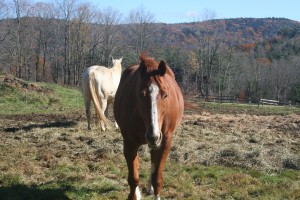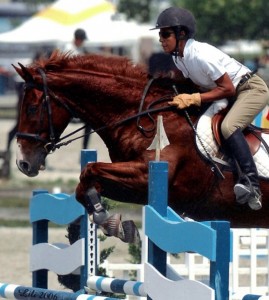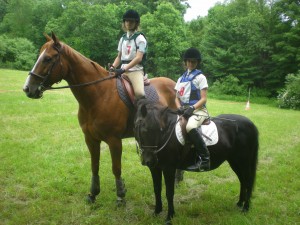Natural Horsemanship veteran Farah DeJohnette’s methodology starts in the stall.
The “home visit” figures right up there among other important details of buying a horse, from physical conformation to a clean bill of health. This is tantamount to choosing any breed, Warmblood, Thoroughbred or something else.
Stating she has a “knack” for picking low-key Thoroughbreds in this way, DeJohnette says, “I go into the stall because that’s where the horse is who he is. This is where he lets down his track energy.”
And the results speak for themselves. In her 20 years training horses through a method that gains an equine’s trust and cooperative spirit, she has taught her Warmblood to jump with her, at a canter, and without a bridle! And Thoroughbreds and other breeds have been taught to loosen, relax and work collaboratively in disciplines, which include trail riding, dressage, hunter/jumper and reining.
Race name: Homeland Security
New name: AKA James
Sire: Corporate Report
Dam: Sportin’ Woman
Foal date: April 2, 2001
In his stall at Penn National is where DeJohnette met her all-time favorite horse, an off-track Thoroughbred named Homeland Security, now known as James.
“When I met James in his stall, he was the most soft, friendly horse I’d met. He turned his head to me as if to say, ‘Don’t you just want to love on me?’ It was as though he was asking me to rub his face and hug him.”
Her years of experience had shown her that horses who are flighty, or flinch away from the touch in their stall may have personality issues to overcome. By contrast, she recognized James as an equine gem.
Working through a service called Mix n’ Match, which helps connect buyers with off-track Thoroughbreds, DeJohnette found the 16-hand Chestnut with white blaze and socks roughly three years ago.
He was the type of horse that nobody could pass by without commenting. “Everybody would tell me James was such a nice horse and he really was,” she says. “His energy is so kind and sweet and gentle.”
She laughs now when she thinks about how his personality first affected her. “I imagined he felt a little dejected because he wasn’t a good racehorse,” DeJohnette says. “I always talk to the horses and I told him I thought I had a job for him that he’d be really good at.”
She proved correct.
After four or five months of training, James was purchased by a young girl, and ran “double-clean” is his first event years ago. He went on to finish in the top six at numerous horse trials. “He jumped cross country, did a dressage test, and did all the natural jumps, and he didn’t have any penalties.
“He started a totally new career, in a new environment, and he just went out and did it like he’d been doing it his entire life.”
James was rare, true, but his story of transitioning from the racetrack into a successful off-track life through Natural Horsemanship training, is not unusual one.
By working with a horse’s natural herd instinct, Natural Horsemanship techniques attempt to build order, trust, and establish bonds that closely resemble relationships that exist naturally between horses.
It has worked so well with Thoroughbreds she has trained that there have been times she has suggested an ex-racehorse might fit a client’s bill better than a Warmblood.
“I work in the show world surrounded by a lot of people who have this notion, ‘I want a warmblood.’ I tell them the Thoroughbred is often a better horse, purely from a technical standpoint. And they’ll tell me, ‘Well, it’s just a Thoroughbred.’
“But I’ve realized that I can train a Thoroughbred into being a highly competitive sport horse that won’t break the bank.”
A natural tendency to want to work combined with Natural Horsemanship is a combination that often brings out the best in Thoroughbreds, DeJohnette says.
“To me, Natural Horsemanship was invented for track horses, and horses who have lived in a high-alert state,” she says.
Through trust-building exercises and inducements to bring out the horse’s desire to want to do a task, she has been rewarded by the horse’s willingness to partner up.
After all, the horse is ultimately “choosing” whether to cooperate or not, she notes.
“I don’t care how much restraint you put on a 1,200 pound horse. If he’s frightened, he can snap a leather strap so easily. The point is to let him choose to work,” DeJohnette says. “I always tell people a horse is not under control to me unless he’s choosing to be under control. After all, I’ve been on many horses in my life who don’t care what’s in their mouth. When they decide they’re done, they’re done.”
But when they decide they’re part of your team, and they’re willing, there’s nothing like it. And factor in a Thoroughbred, and the combination can be very winning.
“I have Warmbloods, and they’re great. But I just have a soft spot for Thoroughbreds. And when they go to a show, if they want to work for me, it gives them a real competitive edge against horses who are coerced to work.”
(Please see DeJohnette jumping Mercury, her gelding, without a bridle).
9.22.2010
9.10.2010
Warming up and the importance of it
I would like to impress upon people the importance of simply Warming up your horse for any type of work. I don't care what discipline you ride you need to warm your horse up in what ever way seems appropriate to the individual.
I tend to address training often using simple logic and this is one of those areas. If you are working your horse at a certain level that requires any suppleness, strength, cardio, or athletic difficulty, you need to warm your horse up properly.
Some things that I will do is read my horses posture to know if my horse is ready to start more demanding work. The video shows what posture I like to have in my horse before I start to ask them to do more focused work.
Ask yourself if you went to work out or do a Yoga class, would you want to go right to a bunch of really difficult exercises cold or would you like to loosen up first and gradually get into more challenging things little by little.
Another thing to think about is how we often try to cram a horse into outlines or frames they would actually choose to take naturally if they were given a choice and a bit of time to relax into it. With no help from you. Yes, The horse would actually offer the very thing you were trying to make happen manually and too early in the ride. This could also cause undo strain and injury to a body that isn't ready to go there yet.
When it comes to arthritic and older horses it is even more important to take longer more gentle warm ups to make sure joints get plenty or blood flow to increase mobility and flexibility. These horses will stay sounder longer and work happier and more comfortably.
I have lots of things I do and they vary from horse to horse from hand walking for several minutes to mounted exercises. I have several video exercises some are more involved then others. Some are on the ground and others are mounted see below for examples.
I tend to address training often using simple logic and this is one of those areas. If you are working your horse at a certain level that requires any suppleness, strength, cardio, or athletic difficulty, you need to warm your horse up properly.
Some things that I will do is read my horses posture to know if my horse is ready to start more demanding work. The video shows what posture I like to have in my horse before I start to ask them to do more focused work.
Ask yourself if you went to work out or do a Yoga class, would you want to go right to a bunch of really difficult exercises cold or would you like to loosen up first and gradually get into more challenging things little by little.
Another thing to think about is how we often try to cram a horse into outlines or frames they would actually choose to take naturally if they were given a choice and a bit of time to relax into it. With no help from you. Yes, The horse would actually offer the very thing you were trying to make happen manually and too early in the ride. This could also cause undo strain and injury to a body that isn't ready to go there yet.
When it comes to arthritic and older horses it is even more important to take longer more gentle warm ups to make sure joints get plenty or blood flow to increase mobility and flexibility. These horses will stay sounder longer and work happier and more comfortably.
I have lots of things I do and they vary from horse to horse from hand walking for several minutes to mounted exercises. I have several video exercises some are more involved then others. Some are on the ground and others are mounted see below for examples.
Labels:
dejohnette,
exercises,
farah,
horsemanship,
loosen,
natural,
stretching,
training,
up,
warm
Subscribe to:
Comments (Atom)


